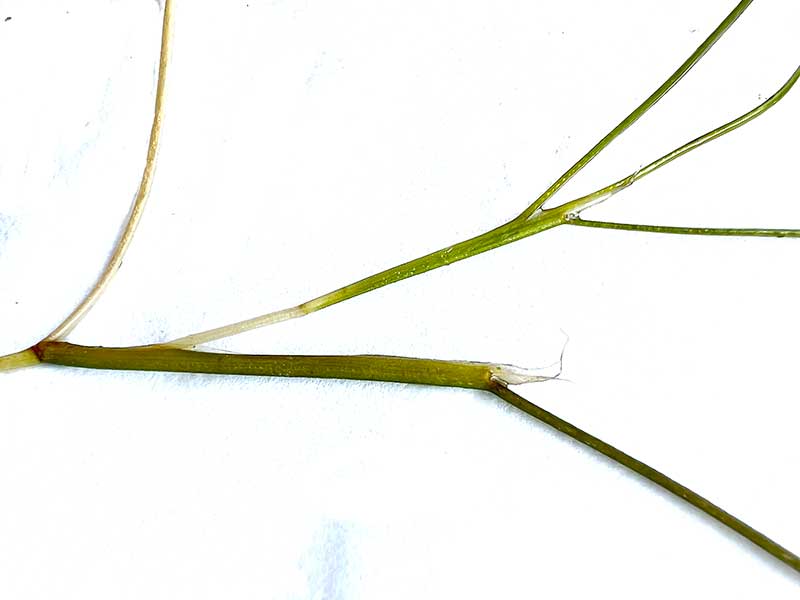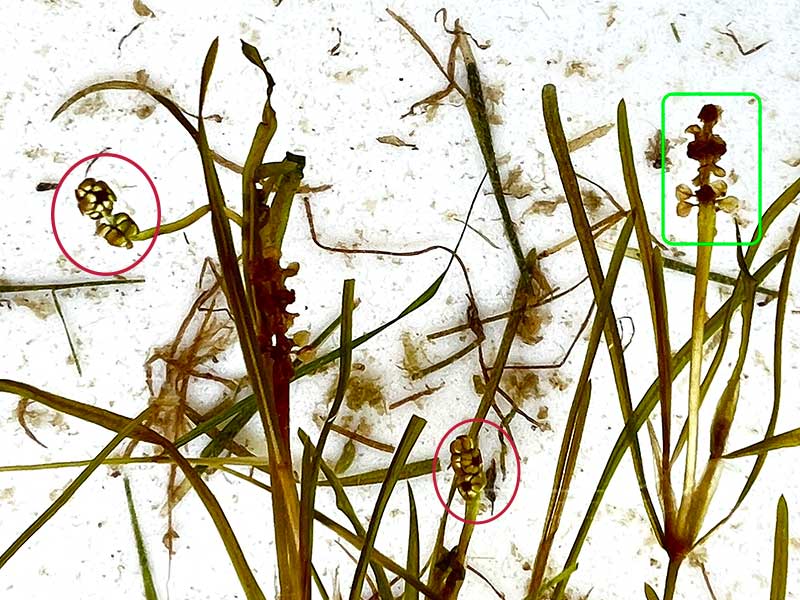Stuckenia pectinata / sago pondweed
- submerged aquatic – dominant in its habitat
- grass-like (but not a grass); waves in the current
- branched with ~5″ pointed leaves
Also known as: fennel-leaf pondweed, sago false pondweed, ribbon weed, comb pondweed, thin-leaved pondweed
Synonyms: Potamogeton pectinatus, Coleogeton pectinatus
Sago pondweed is a perennial submerged aquatic plant growing up to 3 feet long. In much of the upper Teton River, it is the dominant species, looking like waving grass just below the surface. Whenever there are other species, they tend to be entwined with sago pondweed. Unfortunately, this includes some “nuisance algae” although this doesn’t seem to be a big problem in the Valley.
But this isn’t a grass. If you pull a handful out of the river and get somewhere calm, like home, where you can let it float about, you’ll see that it is branched, the leaves being up to 5 inches long. The leaves are thin (less than 1 mm wide) with “sharp” tips, no teeth and no hairs. At the bases of the leaves, there are sheath-like stipules that wrap tightly around the stems. One of the gallery photos illustrates this.
If you’re lucky enough, you’ll also have grabbed some flowers. The flowers are on spikes produced here and there from the leaf axils or stem tips. They’re only ½-1½ inch long and occur in clusters, up to 6 per spike. The flowers themselves are greenish or white, and only ⅛ inch across… so, teeny. Although this is a monocot, each flower actually has 4 tepals, 4 stamens and a pistil with a short style. (Although at this size, it’s hard to imagine a long one). Flowering can happen from late spring until into the fall. The flowers remain submerged and are pollinated via water, although some sources say they are emergent and wind pollinated. I think there is some confusion here, and not just mine. In the gallery, there is a photo with the inflorescence surrounded by a green box.
Like other submerged aquatics, sago pondweed is rooted in the muck. The roots are fibrous, but there are also rhizomes and tubers. Thus, large colonies of the plants are indeed clones.
Sago pondweed prefers clear, alkaline and calcareous, slowly moving water, meaning that the Teton River is just about as good a habitat as you could find for it.
Interesting bits – Sago pondweed tubers are an important food source for water fall, including ducks, geese and swans. Mostly, they eat the shallow ones; those buried deeper tend to survive and rejuvenate the population. If you see upside down ducks on the river, they are quite likely eating this plant.
Sago pondweed has a nearly worldwide distribution and is native to most of Canada and all of the United States, except Hawaii (where some fool introduced it). It is also found almost everywhere else in the world.
In case you are experimentally inclined, sago pondweed can be cultured in liquid media for experimental purposes from druplets (the very small, fruit), or turions. Interestingly, some sources report the plant to have rhizomes but not turions; others insist there are turions. A photo in the gallery shows two groups of druplets (in red ovals).
So just what is a turion? Turion derives from the Latin word for “shoot” and it is a type of bud which, by itself, can grow a new plant. In my experience, they are mostly found in aquatic plant species, including duckweed (Lemna spp.), Utricularia, other pondweeds and millfoil. In general, it is a way for the species to avoid unfavorable conditions and still persist. Though they may be frost hardy, their big advantage is that they sink to the bottom of the river (or lake or pond) and thus avoid actually freezing. So basically, it’s this hard, hardy bud that forms when conditions look bad.
| Blossom size | |
|---|---|
| Color | |
| Family | |
| Inflorescence size | |
| Inflorescence type | |
| When? | |
| Where? |




